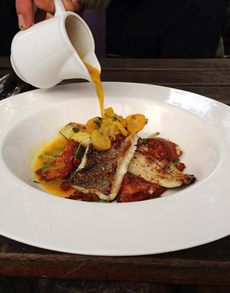TIP OF THE DAY: Branzino, a.k.a. European Seabass & Loup de Mer
|
|
According to Datassential MenuTrends, which tracks more than one million different menu items at more than 7,000 chain and independent restaurants, shrimp, tuna and salmon are among the top seafood items on American menus.
Swimming onto menus nationwide, branzino, a silvery denizen of the Mediterranean Sea and a member of the bass family, currently appears on just 1% of all menus. But it is the fastest-growing fish or seafood, showing up on 28% more menus since 2008—maybe even more if you combine all the different names by which it is known. |
|
|
Branzino is the Northern Italian name for the fish, which is called Mediterranean seabass in the U.K.; loup de mer in France; branzino, branzini, bronzini, spigola or ragno in different parts of Italy; lubina or róbalo in Spain; levrek in Turkey and lavraki in Greece. Branzino/European seabass was one of the first varieties of fish, after salmon, to be farmed commercially in Europe. It was historically cultured in coastal lagoons and tidal reservoirs. Mass-production techniques developed in the late 1960s took production inland. Today, branzino is the most important commercial fish widely cultured in the Mediterranean. Greece, Turkey, Italy, Spain, Croatia, and Egypt are major branzino farming countries.* |
||
|
HOW DOES BRANZINO TASTE? Branzino has a very mild flavor, with sweeter flesh than most white fish. It’s very easy to eat whole off the bone, or to fillet at home. A popular preparation is to roast branzino whole, stuffed with lemon and herbs. You can roast the whole fish at a high heat, stuffed with fresh lemon and parsley or thyme; then cook it briefly under the broiler to crisp the skin.† Or, try these recipes: |
Branzino fresh from the farm. Photo courtesy Aquanor-USA.com. |
|
|
|
||




